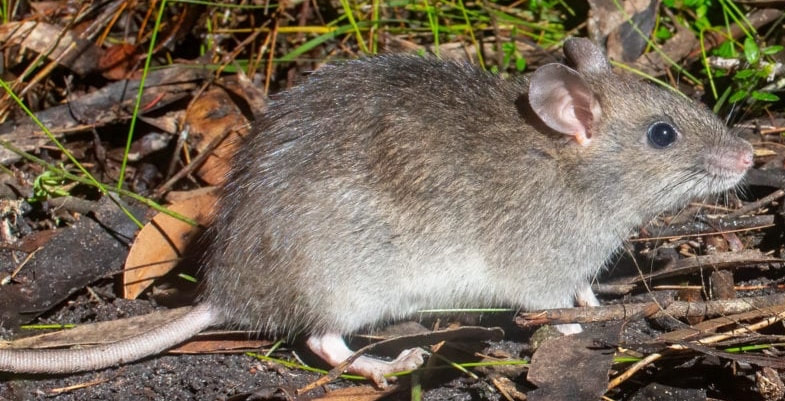Are you hearing something scrambling in your ceiling? Is there evidence of wildlife on your property?
It could be an invading rodent or it could be a native marsupial, which are increasingly threatened with extinction.
Don’t just poison them.
Trap them humanely to identify them before killing the vermin species or releasing the natives.
The most likely introduced species will be feral black rats (Rattus rattus), brown rats (Rattus norvegicus) or house mice (Mus musculus). However, if you live in or near bushland, they could also be native Australian bush rats (Rattus fuscipes), a marsupial mouse known as an Antechinus or even a rare Phascogale, a carnivorous marsupial. There are other possible species and sub-species, but these are the main ones.
Why you should not put out poison
Using rat poison indiscriminately kills everything that eats it. Then it keeps on killing by secondary ingestion when predators eat the poisoned animal. Our native owls, frogmouths and birds of prey are regular victims of secondary poisoning when they catch or scavenge poisoned rodents, as are native marsupial predators like quolls and Phascogales and even goannas. Your own cat or dog can also become victims of secondary poisoning.
How to catch the culprit without killing it
Myall Koala & Environment Group now has a few small animal traps for loan with a security deposit of $20. Known as Elliott traps, they are a long metal box with a trap door that will catch rat-sized creatures. They are easily baited with a ball of food such as rolled oats, honey and peanut butter balls.
It could be an invading rodent or it could be a native marsupial, which are increasingly threatened with extinction.
Don’t just poison them.
Trap them humanely to identify them before killing the vermin species or releasing the natives.
The most likely introduced species will be feral black rats (Rattus rattus), brown rats (Rattus norvegicus) or house mice (Mus musculus). However, if you live in or near bushland, they could also be native Australian bush rats (Rattus fuscipes), a marsupial mouse known as an Antechinus or even a rare Phascogale, a carnivorous marsupial. There are other possible species and sub-species, but these are the main ones.
Why you should not put out poison
Using rat poison indiscriminately kills everything that eats it. Then it keeps on killing by secondary ingestion when predators eat the poisoned animal. Our native owls, frogmouths and birds of prey are regular victims of secondary poisoning when they catch or scavenge poisoned rodents, as are native marsupial predators like quolls and Phascogales and even goannas. Your own cat or dog can also become victims of secondary poisoning.
How to catch the culprit without killing it
Myall Koala & Environment Group now has a few small animal traps for loan with a security deposit of $20. Known as Elliott traps, they are a long metal box with a trap door that will catch rat-sized creatures. They are easily baited with a ball of food such as rolled oats, honey and peanut butter balls.
Contact us on [email protected] if you want to try a more environmentally friendly way of fixing your problem.
When collecting it from us, you will be shown how to use the traps and there are short instructional videos online, such as: https://www.youtube.com/watch?v=mHJJTuWwV38
How to identify what you have caught
Comparison of black rats and native bush rats
|
|
|
Black rats are not necessarily black but can be grey or brown with pale underbelly. The tail is always longer than the body. It has a long face and large rounded ears.
|
Bush rats are natives and can be grey brown to red brown with a shorter face with rounded nose and rounded ears. The tail is never longer than the body. It is much cuter than insidious black rat.
|
ANTECHINUS
These are the size of a mouse or baby rat, with a tail the same length as the body or shorter. A tell-tale feature is their extremely pointed face. It is a carnivore so has a set of tiny teeth, not the “bugs bunny” teeth of a rat or mouse.
These are the size of a mouse or baby rat, with a tail the same length as the body or shorter. A tell-tale feature is their extremely pointed face. It is a carnivore so has a set of tiny teeth, not the “bugs bunny” teeth of a rat or mouse.
PHASCOGALE
The Brush-tailed Phascogale is a tree-dwelling marsupial carnivore. It has a characteristic, black, bushy 'bottlebrush' tail, with hairs up to 4 cm long. Its fur is grey above and pale cream below and it has conspicuous black eyes and large naked ears.
The Brush-tailed Phascogale is a tree-dwelling marsupial carnivore. It has a characteristic, black, bushy 'bottlebrush' tail, with hairs up to 4 cm long. Its fur is grey above and pale cream below and it has conspicuous black eyes and large naked ears.
How to take part in MKEG surveys of native marsupials
If you want to take part in important research on threatened native species in the Lower Myall area, MKEG would love to hear about what native marsupials or other native creatures you find in your traps.
You can tell us through our Facebook page: Myall Koala and Environment Group.
https://www.facebook.com/groups/2431819320403077 )
Or by filling in a short form on our website at myallkoala.org






